Evergreen Formation
The Evergreen Formation is a Pliensbachian to Toarcian geologic formation of the Surat Basin in New South Wales and Queensland, eastern Australia. Traditionally it has been considered to be a unit whose age has been calculated in between the Pliensbachian and Toarcian stages of the Early Jurassic, with some layers suggested to reach the Aalenian stage of the Middle Jurassic, yet modern data has found that an Early Pliensbachian to Latest Toarcian age is more possible.[4][5][6] The formation was named due to the "Evergreen Shales", defined with a lower unit, the Boxvale Sandstone, and a partially coeval, partially younger upper unit, the Westgrove Ironstone Member.[7] This unit overlies the Hettangian-Sinemurian Precipice Sandstone, as well several informal units such as the Nogo Beds, and Narayen beds, as well Torsdale Volcanics.[7] This unit likely was deposited in a massive lacustrine body with possible marine environment influences.[8]
| Evergreen Formation | |
|---|---|
| Stratigraphic range: Lower Pliensbachian- Late Toarcian ~[1] | |
| Type | Geological formation |
| Unit of | Bundamba Group |
| Sub-units | Boxvale Sandstone & Westgrove Ironstone Members |
| Underlies | Hutton Sandstone |
| Overlies | Precipice Sandstone |
| Thickness | Up to 255 m (837 ft) |
| Lithology | |
| Primary | Sandstone, siltstone, mudstone |
| Other | Coal, ironstone |
| Location | |
| Coordinates | 25.8°S 150.3°E |
| Approximate paleocoordinates | 61.7°S 90.0°E |
| Region | |
| Country | |
| Extent | |
| Type section | |
| Named for | "Evergreen Shales" |
| Named by | Hogetoorn[3] |
 Evergreen Formation (Australia) | |
Fossil content
Indeterminate Unionoid bivalves are know from the Kolane Station.[9]
Ichnofossils
| Genus | Species | Type | Location | Material | Origin | Notes | Images |
|---|---|---|---|---|---|---|---|
|
Fodinichnia |
|
Radiating bulb-like swelling burrows |
Annelid worm, vermiform organism |
Freshwater/Blackish burrow-like ichnofossils |
||
|
|
trails |
Gastropods |
Freshwater/Blackish fillings-like ichnofossils |
|||
|
Cylindrichnus[10] |
|
|
Long, subconical, weakly curved burrows |
|
Freshwater/Blackish burrow-like ichnofossils |
||
|
Domichnia |
"U"-shaped burrows |
|
Marine-Mangroove Vertical, U-shaped, single-spreite Burrows; unidirectional or bidirectional spreite, generally continuous, rarely discontinuous. Most Diplocraterion show only protrusive spreiten, like the local ones, produced under predominantly erosive conditions where the organism was constantly burrowing deeper into the substrate as sediment was eroded from the top. |
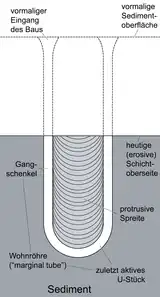 Diplocraterion parallelum diagram | ||
|
Fodinichnia |
Simple, unbranched, horizontal cylinder traces |
Saltwater/Blackish burrow-like ichnofossils. |
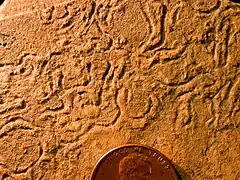 Example of Helminthopsis fossil | |||
|
Lockeia[10] |
|
|
Dwelling traces |
|
Marine, brackish or freshwater resting traces of Bivalves. |
 | |
|
Naktodemasis[10] |
|
Fodinichnia |
Straight to sinuous, unlined and unbranched burrows |
|
Freshwater/Terrestrial burrow-like ichnofossils. |
||
|
Palaeophycus[10] |
|
Domichnia |
Straight or gently curved tubular burrows. |
|
Freshwater/Blackish burrow-like ichnofossils. |
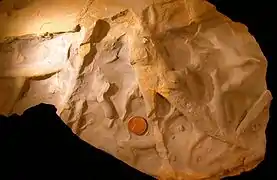 Example of Palaeophycus fossil | |
|
Fodinichnia |
Irregularly meandering burrows |
Vermiform Animals |
Freshwater burrow-like ichnofossils. |
|||
|
Pascichnia |
Cylindrical or elliptical curved/tortuous trace fossils |
|
Freshwater/Blackish burrow-like ichnofossils. Planolites is really common in all types of the Ciechocinek Formation deposits. It is referred to vermiform deposit-feeders, mainly Polychaetes, producing active Fodinichnia. It is controversial, since is considered a strictly a junior synonym of Palaeophycus. |
 Example of Planolites fossil | ||
|
|
Symmetrical trail or burrow |
Gastropods |
Freshwater/Blackish trail-like ichnofossils |
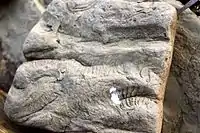 Scolicia trails | ||
|
Domichnia |
Cylindrical strands with branches |
|
Blackish trace ichnofossils. Interpreted as dwelling structures of vermiform animals, more concretely the Domichnion of a suspension-feeding Worm or Phoronidan. |
|||
|
Siphonichnus[10] |
|
Domichnia |
Cylindrical strands with branches |
|
Blackish trace ichnofossils. Interpreted as dwelling structures of vermiform animals, more concretely the Domichnion of a suspension-feeding Worm or Phoronidan. |
||
|
Fodinichnia |
Unlined meniscate burrows |
|
Freshwater/Blackish burrow-like ichnofossils. Taenidium is a meniscate backfill structure, usually considered to be produced by an animal progressing axially through the sediment and depositing alternating packets of differently constituted sediment behind it as it moves forward. |
|||
|
Tubular Fodinichnia |
Tubular Burrows |
|
Burrow-like ichnofossils. Large burrow-systems consisting of smooth-walled, essentially cylindrical components. Common sedimentary features are Thalassinoides trace fossils in the fissile marlstone to claystone intervals |
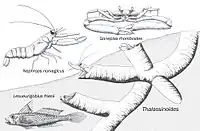 Thalassinoides burrowing structures, with modern related fauna, showing the ecological convergence and the variety of animals that left this Ichnogenus. | ||
|
Fodinichnia |
Vertical to oblique, unbranched or branched, elongated to arcuate spreite burrow |
|
Saltwater/Blackish burrow-like ichnofossils. The overall morphology and details of the burrows, in comparison with modern analogues and neoichnological experiments, suggest Echiurans (spoon worms) or Holothurians (sea cucumbers) with a combined suspension- and deposit-feeding behaviour as potential producers. |
 Teichichnus burrows | ||
Diplopoda
| Genus | Species | Location | Stratigraphic position | Material | Notes | Images |
|---|---|---|---|---|---|---|
|
Decorotergum[11] |
|
|
Westgrove Ironstone Member |
Incomplete specimens: QMF12294, QMF12295 and one small fragment of a third specimen, QMF12296 |
A millipede whose affinities are controversial. It may be an Oniscomorpha of the order Amynilyspedida family Amynilyspedidae or a member of the order Polydesmida |
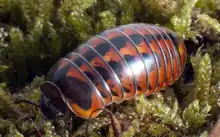 Extant example of the order Amynilyspedida, Glomeris |
Vertebrata
| Genus | Species | Location | Stratigraphic position | Material | Notes | Images |
|---|---|---|---|---|---|---|
|
Indeterminate |
|
Westgrove Ironstone Member |
|
A Freshwater Plesiosaur with affinities with Pliosauridae and Neoplesiosauria |
||
|
Siderops kehli |
|
Westgrove Ironstone Member |
|
A gigantic chigutisaurid temnospondyl, representing a relictual genus isolated in the Australian Ecoregion, as well one of the largest Mesozoic amphibians |
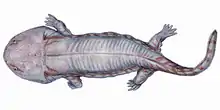 Restoration of Siderops kehli | |
Phytoplankton
| Genus | Species | Stratigraphic position | Material | Notes | Images |
|---|---|---|---|---|---|
|
Chomotriletes[14] |
|
|
|
Affinities with the family Zygnemataceae. A genus derived from freshwater filamentous or unicellular, uniseriate (unbranched) green algae. |
|
Bryophyta
| Genus | Species | Stratigraphic position | Material | Notes | Images |
|---|---|---|---|---|---|
|
Anapiculatisporites[14] |
|
|
|
Incertae sedis; affinities with Bryophyta. |
|
|
Cingutriletes[14] |
|
|
|
Incertae sedis; affinities with Bryophyta. |
|
|
Distalanulisporites[14] |
|
|
|
Affinities with the family Sphagnaceae in the Sphagnopsida. |
|
|
Foraminisporis[1] |
|
|
|
Affinities with the family Notothyladaceae in the Anthocerotopsida. |
|
|
|
|
Incertae sedis; affinities with Bryophyta. This spore is found in Jurassic sediments associated with the polar regions. |
||
|
|
|
Affinities with the family Notothyladaceae in the Anthocerotopsida. Hornwort spores. |
).png.webp) Extant Notothylas specimens | |
|
Rogalskaisporites[14] |
|
|
|
Affinities with the family Sphagnaceae in the Sphagnopsida. |
|
|
|
|
Affinities with the family Sphagnaceae in the Sphagnopsida. "Peat moss" spores, related to genera such as Sphagnum that can store large amounts of water. |
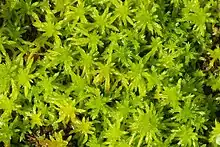 Extant Sphagnum specimens | |
|
|
|
Affinities with the family Encalyptaceae in the Bryopsida. Branching moss spores, indicating high water-depleting environments. |
_2281.JPG.webp) Extant Encalypta specimens; Staplinisporites probably come from similar genera | |
Lycophyta
| Genus | Species | Stratigraphic position | Material | Notes | Images |
|---|---|---|---|---|---|
|
Antulsporites[14] |
|
|
|
Affinities with the Selaginellaceae in the Lycopsida. |
|
|
Apiculatisporis[14] |
|
|
|
Incertae sedis; affinities with Lycopodiopsida |
|
|
|
|
Affinities with the Selaginellaceae in the Lycopsida. Herbaceous lycophyte flora, similar to ferns, found in humid settings. This family of spores are also the most diverse in the formation. |
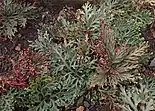 Extant Selaginella, typical example of Selaginellaceae | |
|
|
|
Affinities with the family Lycopodiaceae in the Lycopodiopsida. Lycopod spores, related to herbaceous to arbustive flora common in humid environments. |
||
|
|
|
Affinities with the family Lycopodiaceae in the Lycopodiopsida. Lycopod spores, related to herbaceous to arbustive flora common in humid environments. |
 Extant Lycopodium specimens | |
|
Neoraistrickia[14] |
|
|
|
Affinities with the Selaginellaceae in the Lycopsida. |
|
|
|
|
Incertae sedis; affinities with Lycopodiopsida. |
||
|
Retitriletes[14] |
|
|
|
Affinities with the family Lycopodiaceae in the Lycopodiopsida. |
|
|
Lycopodiumsporites[14] |
|
|
|
Affinities with the family Lycopodiaceae in the Lycopodiopsida. Lycopod spores, related to herbaceous to arbustive flora common in humid environments. |
|
|
Uvaesporites[14] |
|
|
|
Affinities with the Selaginellaceae in the Lycopsida. |
|
Pteridophyta
| Genus | Species | Stratigraphic position | Material | Notes | Images |
|---|---|---|---|---|---|
|
|
|
Affinities with the genus Saccoloma, type representative of the family Saccolomataceae. This fern spore resembles those of the living genus Saccoloma, being probably from a pantropical genus found in wet, shaded forest areas. |
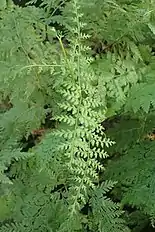 Extant Saccoloma specimens; Annulispora probably comes from similar genera or maybe a species in the genus | |
|
|
|
Affinities with the family Osmundaceae in the Polypodiopsida. Near fluvial current ferns, related to the modern Osmunda regalis. |
_-_Cape_St._Mary's_Ecological_Reserve%252C_Newfoundland_2019-08-10.jpg.webp) Extant Osmunda specimens; Baculatisporites and Todisporites probably come from similar genera or maybe a species from the genus | |
|
Biretisporites[14] |
|
|
|
Affinities with the Marattiaceae in the Polypodiopsida. Fern spores from low herbaceous flora. |
|
|
Cingulatisporites[14] |
|
|
|
Incertae sedis; affinities with the Pteridophyta |
|
|
Clavatisporites[14] |
|
|
|
Incertae sedis; affinities with the Pteridophyta |
|
|
Cyathidites[14] |
|
|
|
Affinities with the family Cyatheaceae in the Cyatheales. Arboreal fern spores. |
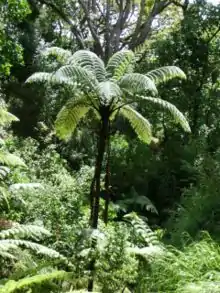 Extant Cyathea |
|
|
|
Affinities with the family Matoniaceae in the Gleicheniales. |
||
|
|
|
Affinities with the family Matoniaceae in the Gleicheniales. |
||
|
Duplexisporites[14] |
|
|
|
Incertae sedis; affinities with the Pteridophyta |
|
|
Foveosporites[14] |
|
|
|
Incertae sedis; affinities with the Pteridophyta |
|
|
|
|
Affinities with the Gleicheniales in the Polypodiopsida. Fern spores from low herbaceous flora. |
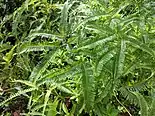 Extant Gleichenia specimens; Gleicheniidites probably come from similar genera or maybe a species in the genus | |
|
Granulatisporites[14] |
|
|
|
Affinities with the Pteridaceae in the Polypodiopsida. Forest ferns from humid ground locations. |
.jpg.webp) Extant Pityrogramma specimens |
|
Heliosporites[14] |
|
|
|
Incertae sedis; affinities with the Pteridophyta |
|
|
|
|
Incertae sedis; affinities with the Pteridophyta |
||
|
|
|
Incertae sedis; affinities with the Pteridophyta |
||
|
|
|
Affinities with the family Dennstaedtiaceae in the Polypodiales. Forest fern spores. |
.jpg.webp) Extant Dennstaedtia specimens; Leptolepidites probably comes from similar genera | |
|
|
|
Affinities with the family Matoniaceae in the Gleicheniales. |
||
|
Osmundacidites[14] |
|
|
|
Affinities with the family Osmundaceae in the Polypodiopsida. Near fluvial current ferns, related to the modern Osmunda regalis. |
|
|
Peroaletes[14] |
|
|
|
Incertae sedis; affinities with the Pteridophyta |
|
|
Perotrilites[14] |
|
|
|
Incertae sedis; affinities with the Pteridophyta |
|
|
Polypodiisporites[14] |
|
|
|
Affinities with the family Dennstaedtiaceae in the Polypodiales. Forest fern spores. |
|
|
Rugulatisporites[14] |
|
|
|
Affinities with the family Osmundaceae in the Polypodiopsida. Near fluvial current ferns, related to the modern Osmunda regalis. |
|
Peltaspermales
| Genus | Species | Stratigraphic position | Material | Notes | Images |
|---|---|---|---|---|---|
|
|
|
Affinities with the families Peltaspermaceae, Corystospermaceae or Umkomasiaceae in the Peltaspermales. Pollen of uncertain provenance that can be derived from any of the members of the Peltaspermales. The lack of distinctive characters and poor conservation make this pollen difficult to classify. Arboreal to arbustive seed ferns. |
||
|
Kekryphalospora[1] |
|
|
|
Affinities with the families Peltaspermaceae, Corystospermaceae or Umkomasiaceae in the Peltaspermales. Extremely abundant |
|
|
|
|
From the family Caytoniaceae in the Caytoniales. Caytoniaceae are a complex group of Mesozoic fossil floras that may be related to both Peltaspermales and Ginkgoaceae. |
||
Cycadophyta
| Genus | Species | Stratigraphic position | Material | Notes | Images |
|---|---|---|---|---|---|
|
Cycadopites[14] |
|
|
|
Affinities with the family Cycadaceae in the Cycadales or with Cycadaceae and Bennettitaceae. It has been found associated with the Bennetite pollen cone Bennettistemon |
 Extant Cycas platyphylla |
Conifers
| Genus | Species | Stratigraphic position | Material | Notes | Images |
|---|---|---|---|---|---|
|
|
|
Affinities with the family Araucariaceae in the Pinales. Conifer pollen from medium to large arboreal plants. |
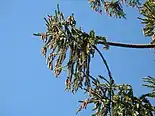 Extant Araucaria. Callialasporites may come from a related plant | |
|
Callialasporites[10] |
|
|
|
Affinities with the family Araucariaceae in the Pinales. Conifer pollen from medium to large arboreal plants. |
|
|
|
|
Affinities with the Hirmeriellaceae in the Pinopsida. |
||
|
|
|
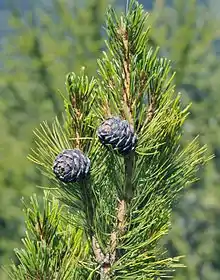 Extant Pinus cembra Cone, example of the Pinidae. Inaperturopollenites is similar to the pollen found on this genus | ||
|
|
|
Affinities with the family Podocarpaceae inside Coniferae. |
||
|
|
|
Affinities with the family Cupressaceae in the Pinopsida. Pollen that resembles that of extant genera such as the genus Actinostrobus and Austrocedrus, probably derived from dry environments. |
 Extant Austrocedrus | |
|
Podocarpidites[14] |
|
|
|
Affinities with the family Podocarpaceae. Pollen from diverse types of Podocarpaceous conifers, that include morphotypes similar to the low arbustive Microcachrys and the medium arbustive Lepidothamnus, likely linked with Upland settings |
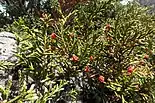 Extant Microcachrys |
|
|
|
Affinities with the family Podocarpaceae. |
||
|
Trisaccites[14] |
|
|
|
Affinities with the family Podocarpaceae. |
|
|
|
|
Affinities with the family Pinaceae in the Pinopsida. Conifer pollen from medium to large arboreal plants. |
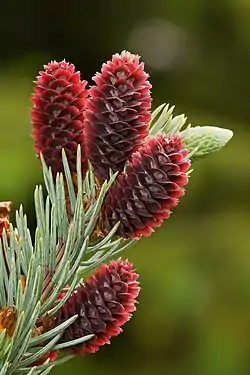 Extant Picea. | |
References
- La Croix, Andrew D.; Sobczak, Kasia; Esterle, Joan S.; Bianchi, Valeria; Wang, Jiahao; He, Jianhua; Hayes, Phil; Underschultz, Jim R.; Garnett, Andrew (2022). "Integrating palynostratigraphy with zircon geochronology in the Lower Jurassic Precipice Sandstone and Evergreen Formation to improve stratigraphic correlation within the Great Artesian Basin, Australia". Marine and Petroleum Geology. 144 (4): 56–89. doi:10.1016/j.marpetgeo.2022.105845. ISSN 0264-8172.
- Waschbusch, P.; Korsch, R.J.; Beaumont, C. (2009). "Geodynamic modelling of aspects of the Bowen, Gunnedah, Surat and Eromanga Basins from the perspective of convergent margin processes". Australian Journal of Earth Sciences. 56 (3): 309–334. Retrieved 31 May 2023.
- Hogetoorn, D.J. (1967). "Jurassic reservoirs of the Surat Basin". World Petroleum Congress. 7: 161–170. Retrieved 31 May 2023.
- "Australian Government- Geoscience Australia Australian Stratigraphic Units Database". ga.gov.au. Geoscience Australia. Retrieved 19 January 2015.
- Todd, Christopher N.; Roberts, Eric M.; Knutsen, Espen M.; Rozefelds, Andrew C.; Huang, Hui-Qing; Spandler, Carl (December 2019). "Refined age and geological context of two of Australia's most important Jurassic vertebrate taxa (Rhoetosaurus brownei and Siderops kehli), Queensland". Gondwana Research. 76: 19–25. doi:10.1016/j.gr.2019.05.008.
- Sobczak, Kasia; La Croix, Andrew D.; Esterle, Joan; Hayes, Phil; Holl, Heinz-Gerd; Ciesiolka, Rachael; Crowley, James L.; Allen, Charlotte M. (2022). "Geochronology and sediment provenance of the Precipice Sandstone and Evergreen Formation in the Surat Basin, Australia: Implications for the palaeogeography of eastern Gondwana". Gondwana Research. 111: 189–208. doi:10.1016/j.gr.2022.08.003. ISSN 1342-937X.
- Withnall, I. W.; Hutton, L. J.; Bultitude, R. J.; Von Gnielinski, F. E.; Rienks, I. P. (2009). "Geology of the Auburn Arch, southern Connors Arch and adjacent parts of the Bowen Basin and Yarrol Province, central Queensland". Queensland Geology. 12 (2): 13–32. Retrieved 31 May 2023.
- Martin, M.; Wakefield, M.; Bianchi, V.; Esterle, J.; Zhou, F. (2017). "Evidence for marine influence in the Lower Jurassic Precipice Sandstone, Surat Basin, eastern Australia". Australian Journal of Earth Sciences. 65 (1): 75–91. Retrieved 31 May 2023.
- Warren, A. A.; Hutchinson, M. N. (1983). "The Last Labyrinthodont? A New Brachyopoid (Amphibia, Temnospondyli) from the Early Jurassic Evergreen Formation of Queensland, Australia". Philosophical Transactions of the Royal Society B: Biological Sciences. 303 (1113): 1–62. Bibcode:1983RSPTB.303....1W. doi:10.1098/rstb.1983.0080. Retrieved 30 March 2022.
- La Croix, A. D.; Wang, J.; He, J.; Hannaford, C.; Bianchi, V.; Esterle, J.; Undershultz, J. R. (2019). "Widespread nearshore and shallow marine deposition within the Lower Jurassic Precipice Sandstone and Evergreen Formation in the Surat Basin, Australia". Marine and Petroleum Geology. 109 (3): 760–790. Retrieved 30 May 2023.
- Jell, P. A. (1983). "An Early Jurassic millipede from the Evergreen Formation in Queensland". Alcheringa. 7 (3): 195–199. Retrieved 30 May 2023.
- Thulborn, Richard A; Warren, Anne (1980). "Early Jurassic plesiosaurs from Australia". Nature. 285 (57): 224–225. Retrieved 30 May 2023.
- Kear, B. P. (2012). "A revision of Australia's Jurassic plesiosaurs". Palaeontology. 55 (5): 1125–1138. Retrieved 30 May 2023.
- McKellar, J. L. (1974). "Jurassic miospores from the upper Evergreen Formation, Hutton Sandstone, and basal Injune Creek Group, north-eastern Surat Basin". Geological Survey of Queensland. 361 (35): 1–47 – via ResearchGate.
- Paten, R.J. (1967). "Microfloral distribution in the Lower Jurassic Evergreen Formation of the Boxvale area, Surat Basin,Queensland". Queensland Government Mining Journal. 68 (79): 345–349.
Further reading
- Warren, A. (1977). "Jurassic labyrinthodont". Nature. 265 (2): 436–437. Retrieved 31 May 2023.